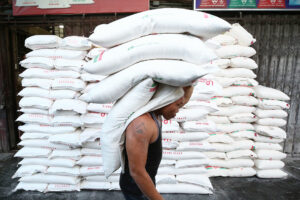THE inventory of rice declined 17.5% at the start of May, the Philippine Statistics Authority (PSA) said.
In a report, the PSA said that the rice inventory during the period was 1.88 million metric tons (MT), with holdings of households, commercial warehouses and the National Food Authority (NFA) all declining.
Rice held by households, which accounted for 52.8% of the total, fell 19.9% year on year to 993.97 thousand MT; while commercial warehouses held 787.97 thousand MT, 10.6% lower from a year earlier. Commercial stocks accounted for 41.9% of the national inventory.
Stocks held by depositories of the NFA, accounted for 5.3% of overall rice inventory. They fell 37% to 100.12 thousand MT during the period.
In a statement, the Samahang Industriya ng Agrikultura (SINAG), said the NFA needs to use its funding to buy more rice from farmers.
SINAG Chairman Rosendo O. So said that the NFA used its P8.5-billion budget, “it could have procured… 290.8 thousand MT of rice, equivalent to 5.8 million bags,” he said.
The NFA had reported that its rice stocks dropped to the equivalent of 1.56 days’ demand, well below its nine-day target inventory level. The NFA said high prices kept it from buying more.
According to the NFA, daily national consumption is 679,670 bags or 33.93 thousand MT.
Month on month, rice stocks rose 2.1%.
“Increases in the rice inventory were noted in both the commercial sector and NFA depositories at 8.1% and 1.1%, respectively; (while) rice in household decreased by 2.1%,” the PSA said.
Meanwhile, the PSA said the corn inventory decreased to 668.70 thousand MT during the period, down 14.2% from a year earlier.
Corn held by commercial establishments was 584.98 thousand MT, equivalent to 87.5% of the national inventory. Commercial holdings were down 13% year on year.
Corn held by households declined 22% year on year to 83.72 thousand MT. This segment accounted for 12.5% of the national total.
Compared to a month earlier, the national corn inventory rose 34.6%. Household stocks dropped 18.6% from April, while commercial inventory rose 48.5%. — Adrian H. Halili

